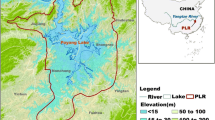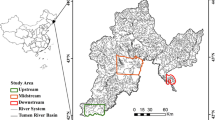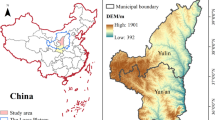Abstract
Understanding the response mechanism of ecosystem services (ES) to landscape patterns is important in regional landscape planning and sustainable development. In this study, the landscape index and InVEST model were used to quantitatively analyze the spatio-temporal evolution of landscape patterns and ES in the Ganjiang River Basin of China from 1990 to 2020. Furthermore, the bivariate Moran’s I method and spatial error model were used to test the spatial correlation between landscape index and ES. The results showed that (1) cropland decreased and construction land increased, and the overall landscape tended to be fragmented, the patch shape complicated, and landscape diversity increased from 1990 to 2020. Water conservation (WC) and soil conservation (SC) capacity increased by 10.56 mm and 16.24 t hm–2 a–1, respectively, whereas carbon storage (CS) decreased by 1.22 t hm–2 a–1. (2) The responses of different typical ES to landscape patterns were different in the landscape index and response degree. Typical ES negatively responded to Shannon’s diversity index and patch density. WC was sensitive to the Splitting Index, whereas SC and CS were more responsive to the average patch area. (3) The overall purpose of territorial spatial planning within a basin should be to reduce the fragmentation and heterogeneity of the landscape. According to four local aggregation patterns of landscape index and ES, corresponding measures can be taken according to local conditions in different regions. These results can provide a quantitative basis for landscape management and ecological construction in the Ganjiang River Basin and scientific guidance for the Yangtze River conservation strategy.








Similar content being viewed by others
CRediT authorship contribution statement
Wei Wan,Yun Huang, and Bofu Zheng conceived the research. Shiwen Wu, Wei Wan and Bofu Zheng wrote the manuscript. Shiwen Wu, Xu Song, Yun Huang, Wei Wan, Bofu Zheng, and Hanqing Wu edited the manuscript. Zhong Liu and Jinqi Zhu contributed to the data collection. All authors reviewed the manuscript.
Abbreviations
- AREA_MN:
-
Mean patch area
- CS:
-
Carbon storage
- DEM:
-
Digital elevation model
- ES:
-
Ecosystem services
- IJI:
-
Interspersion and juxtaposition index
- LISA:
-
Local indicators of spatial association
- LM:
-
Lagrange multipliers
- PD:
-
Patch density
- Ps:
-
Trend and status index of land use types
- R-LM:
-
Robust Lagrange multipliers
- SC:
-
Soil conservation
- SDR:
-
Sediment delivery ratio
- SEM:
-
Spatial error model
- SHAPE_MN:
-
Mean patch shape index
- SHDI:
-
Shannon’s diversity index
- SLM:
-
Spatial lag model
- SPLIT:
-
Landscape splitting index
- TI :
-
Topographic index
- VIF:
-
Variance inflation factor
- WC:
-
Water conservation
References
Bai J, Zhou Z, Li J et al (2022) Predicting soil conservation service in the Jinghe River Basin under climate change. J Hydrol 615:128646. https://doi.org/10.1016/j.jhydrol.2022.128646
Balasubramanian D, Zhou W-J, Ji H-L et al (2020) Environmental and management controls of soil carbon storage in grasslands of southwestern China. J Environ Manage 254:109810. https://doi.org/10.1016/j.jenvman.2019.109810
Baro F, Palomo I, Zulian G et al (2016) Mapping ecosystem service capacity, flow and demand for landscape and urban planning: A case study in the Barcelona metropolitan region. Land Use Pol 57:405–417. https://doi.org/10.1016/j.landusepol.2016.06.006
Bartholomée O, Grigulis K, Colace M-P et al (2018) Methodological uncertainties in estimating carbon storage in temperate forests and grasslands. Ecol Indic 95:331–342. https://doi.org/10.1016/j.ecolind.2018.07.054
Bian J, Chen W, Zeng J (2023) Ecosystem services, landscape pattern, and landscape ecological risk zoning in China. Environ Sci Pollut Res Int 30(7):17709–17722. https://doi.org/10.1007/s11356-022-23435-5
Chen LC, Guan X, Li HM et al (2019) Spatiotemporal patterns of carbon storage in forest ecosystems in Hunan Province, China. For Ecol Manag 432:656–666. https://doi.org/10.1016/j.foreco.2018.09.059
Chen W, Zeng J, Chu Y, et al. (2021) Impacts of Landscape Patterns on ES Value: A Multiscale Buffer Gradient Analysis Approach. Remote Sens. 13(13). https://doi.org/10.3390/rs13132551
Chuai X, Huang X, Lai L et al (2013) Land use structure optimization based on carbon storage in several regional terrestrial ecosystems across China. Environ Sci Policy 25:50–61. https://doi.org/10.1016/j.envsci.2012.05.005
Costanza R, d’Arge R, de Groot R et al (1998) The value of the world’s ecosystem services and natural capital. Ecol Econ 25(1):3–15. https://doi.org/10.1016/S0921-8009(98)00020-2
Dai L, Wang Z (2023) Construction and optimization strategy of ecological security pattern based on ecosystem services and landscape connectivity: a case study of Guizhou Province, China. Environ Sci Pollut Res Int 30(15):45123–45139. https://doi.org/10.1007/s11356-023-25417-7
de Moura FR, da Silva Júnior FMR (2023) 2030 Agenda: discussion on Brazilian priorities facing air pollution and climate change challenges. Environ Sci Pollut Res 30:8376–8390. https://doi.org/10.1007/s11356-022-24601-5
de Groot R, Brander L, van der Ploeg S et al (2012) Global estimates of the value of ecosystems and their services in monetary units. Ecosyst Serv 1(1):50–61. https://doi.org/10.1016/j.ecoser.2012.07.005
Degefu MA, Argaw M, Feyisa GL et al (2021) Dynamics of urban landscape nexus spatial dependence of ES in rapid agglomerate cities of Ethiopia. Sci Total Environ 798:149192. https://doi.org/10.1016/j.scitotenv.2021.149192
Diao J, Liu J, Zhu Z et al (2022) Active forest management accelerates carbon storage in plantation forests in Lishui, southern China. For Ecosyst 9:100004. https://doi.org/10.1016/j.fecs.2022.100004
Du L, Dong C, Kang X et al (2023) Spatiotemporal evolution of land cover changes and landscape ecological risk assessment in the Yellow River Basin, 2015–2020. J Environ Manage 332:117149. https://doi.org/10.1016/j.jenvman.2022.117149
Fang G, Sun X, Liao C et al (2023) How do ecosystem services evolve across urban-rural transitional landscapes of Beijing-Tianjin-Hebei region in China: patterns, trade-offs, and drivers. Landsc Ecol 38(4):1125–1145. https://doi.org/10.1007/s10980-022-01582-x
Fu Q, Zhao X, Yuan F et al (2010) Analysis of Organic Carbon Reserves in Cultivated Land Topsoil of Jiangxi Province. Chin J Soil Sci 41(4):835–838. https://doi.org/10.19336/j.cnki.trtb.2010.04.015
Gao B, Wu DH (2020) The effects of returning farmlands to forests or pastures on soil animal diversity and its regional differentiation characteristics in China: A meta-analysis. Appl Ecol Env Res 18:6335–6353. https://doi.org/10.15666/aeer/1805_63356353
Gao X, Shen J, He W et al (2021) Spatial-temporal analysis of ecosystem services value and research on ecological compensation in Taihu Lake Basin of Jiangsu Province in China from 2005 to 2018. J Clean Prod 317:128241. https://doi.org/10.1016/j.jclepro.2021.128241
Gong W, Duan X, Sun Y et al (2023) Multi-scenario simulation of land use/cover change and carbon storage assessment in Hainan coastal zone from perspective of free trade port construction. J Clean Prod 385:135630. https://doi.org/10.1016/j.jclepro.2022.135630
Guan D, Jiang Y, Cheng L (2022) How can the landscape ecological security pattern be quantitatively optimized and effectively evaluated? An integrated analysis with the granularity inverse method and landscape indicators. Environ Sci Pollut Res 29:41590–41616. https://doi.org/10.1007/s11356-021-16759-1
Guo S, Wu C, Wang Y et al (2022) Threshold effect of ecosystem services in response to climate change, human activity and landscape pattern in the upper and middle Yellow River of China. Ecol Indic 136:108603. https://doi.org/10.1016/j.ecolind.2022.108603
Jing M, Song F, Meng K et al (2023) Optimization of landscape pattern in the main river basin of Liao River in China based on ecological network. Environ Sci Pollut Res Int 30(24):65587–65601. https://doi.org/10.1007/s11356-023-26963-w
Ke X, Tang L (2019) Impact of cascading processes of urban expansion and cropland reclamation on the ecosystem of a carbon storage service in Hubei Province, China. Acta Ecol Sin 39(2):672–683. https://doi.org/10.5846/stxb201712042177
KhosraviMashizi A, Sharafatmandrad M (2021) Investigating tradeoffs between supply, use and demand of ecosystem services and their effective drivers for sustainable environmental management. J Environ Manag 289:112534. https://doi.org/10.1016/j.jenvman.2021.112534
Kuang W, Zhang S, Du G et al (2022) Remotely sensed mapping and analysis of spatio-temporal patterns of land use change across China in 2015–2020. Acta Geographica Sinica 77:1056–1071. https://doi.org/10.11821/dlxb202205002
Leemans HBJ, De Groot R (2003) Millennium Ecosystem Assessment: Ecosystems and Human Well-being: A Framework for Assessment. Island Press, Washington, DC
Li M, Liang D, Xia J et al (2021) Evaluation of water conservation function of Danjiang River Basin in Qinling Mountains, China based on InVEST model. J Environ Manag 286:112212. https://doi.org/10.1016/j.jenvman.2021.112212
Liu W, Liu J, Kuang W et al (2017) Examining the influence of the implementation of Major Function-oriented Zones on built-up area expansion in China. J Geogr Sci 27:643–660. https://doi.org/10.1007/s11442-017-1398-0
Liu L, Chen X, Chen W et al (2020) Identifying the Impact of Landscape Pattern on ecosystem services in the Middle Reaches of the Yangtze River Urban Agglomerations, China. Int J Environ Res Public Health 17(14):5063. https://doi.org/10.3390/ijerph17145063
Liu X, Zhang L, She D et al (2022) Postprocessing of hydrometeorological ensemble forecasts based on multisource precipitation in Ganjiang River basin, China. J Hydrol 605:127323. https://doi.org/10.1016/j.jhydrol.2021.127323
Medeiros A, Fernandes C, Gonçalves JF et al (2022) A diagnostic framework for assessing land-use change impacts on landscape pattern and character – A case-study from the Douro region, Portugal. Landsc Urban Plan 228:104580. https://doi.org/10.1016/j.landurbplan.2022.104580
Mitchell MGE, Devisscher T (2022) Strong relationships between urbanization, landscape structure, and ecosystem service multifunctionality in urban forest fragments. Landsc Urban Plan 228:104548. https://doi.org/10.1016/j.landurbplan.2022.104548
Mitchell MGE, Suarez-Castro AF, Martinez-Harms M et al (2015) Reframing landscape fragmentation’s effects on ecosystem services. Trends Ecol Evol 30(4):190–198. https://doi.org/10.1016/j.tree.2015.01.011
Phillips CL, Wang R, Mattox C et al (2023) High soil carbon sequestration rates persist several decades in turfgrass systems: A meta-analysis. Sci Total Environ 858:159974. https://doi.org/10.1016/j.scitotenv.2022.159974
Shuangao W, Padmanaban R, Mbanze AA et al (2021) Using Satellite Image Fusion to Evaluate the Impact of Land Use Changes on ES and Their Economic Values. Remote Sens 13(5):851. https://doi.org/10.3390/rs13050851
Song S, Yu D, Li X (2023) Impacts of changes in climate and landscape pattern on soil conservation services in a dryland landscape. CATENA 222:106869. https://doi.org/10.1016/j.catena.2022.106869
Tang L, Ke X, Zhou Q et al (2020a) Projecting future impacts of cropland reclamation policies on carbon storage. Ecol Indic 119:106835. https://doi.org/10.1016/j.ecolind.2020.106835
Tang L, Ke X, Zhou T et al (2020b) Impacts of cropland expansion on carbon storage: A case study in Hubei, China. J Environ Manag 265(110515):152126. https://doi.org/10.1016/j.jenvman.2020.110515
Toosi NB, Soffianian AR, Fakheran S et al (2022) Mapping disturbance in mangrove ecosystems: Incorporating landscape metrics and PCA-based spatial analysis. Ecol Indic 136:108718. https://doi.org/10.1016/j.ecolind.2022.108718
Tran DX, Pearson D, Palmer A et al (2022) Quantifying spatial non-stationarity in the relationship between landscape structure and the provision of ecosystem services: An example in the New Zealand hill country. Sci Total Environ 808:152126. https://doi.org/10.1016/j.scitotenv.2021.152126
Tscharntke T, Tylianakis JM, Rand TA et al (2012) Landscape moderation of biodiversity patterns and processes - eight hypotheses. Biol Rev 87(3):661–685. https://doi.org/10.1111/j.1469-185X.2011.00216.x
Wang K, Zhang C, Chen H et al (2019) Karst landscapes of China: patterns, ecosystem processes and services. Landscape Ecol 34:2743–2763. https://doi.org/10.1007/s10980-019-00912-w
Wang J, Wang J, Zhang M et al (2022) The payment scheme for ecosystem services in the coastal city based on the ecosystem services value and current payment efficiency: A case study in Jimo of Qingdao city, China. Environ Sci Pollut Res 29:49179–49193. https://doi.org/10.1007/s11356-022-19321-9
Winkel G, Lovrić M, Muys B et al (2022) Governing Europe’s forests for multiple ES: Opportunities, challenges, and policy options. Forest Policy Econ 145:102849. https://doi.org/10.1016/j.forpol.2022.102849
Wu J (2021) Landscape sustainability science (II): core questions and key approaches. Landsc Ecol 36(8):2453–2485. https://doi.org/10.1007/s10980-021-01245-3
Wu D, Shao Q, Li J et al (2012) Carbon fixation estimation for the main plantation forest species in the red soil hilly region of southern-central Jiangxi Province, China. Acta Ecol Sin 32(1):142–150. https://doi.org/10.5846/stxb201011241669
Xi X, Li M, Zhang X et al (2013) Research on soil organic carbon distribution and change trend in middle east plain and its vicinity in China. Earth Sci Front 20(1):154–165. https://www.earthsciencefrontiers.net.cn/CN/Y2013/V20/I1/154. Accessed 30 Sept 2023
Xie L, Wang H, Liu S (2022) The ecosystem service values simulation and driving force analysis based on land use/land cover: A case study in inland rivers in arid areas of the Aksu River Basin, China. Ecol Indic 138:108828. https://doi.org/10.1016/j.ecolind.2022.108828
Xue J, Li Z, Feng Q et al (2022) Spatiotemporal variations of water conservation and its influencing factors in ecological barrier region, Qinghai-Tibet Plateau. J Hydrol-Reg Stud 42:101164. https://doi.org/10.1016/j.ejrh.2022.101164
Xue C, Chen X, Xue L et al (2023) Modeling the spatially heterogeneous relationships between tradeoffs and synergies among ES and potential drivers considering geographic scale in Bairin Left Banner, China. Sci Total Environ 855:158834. https://doi.org/10.1016/j.scitotenv.2022.158834
Yang D, Zhang P, Jiang L et al (2022) Spatial change and scale dependence of built-up land expansion and landscape pattern evolution—Case study of affected area of the lower Yellow River. Ecol Indic 141:109123. https://doi.org/10.1016/j.ecolind.2022.109123
Yu SX, Wang L, Zhao JS et al (2021) Using structural equation modelling to identify regional socio-economic driving forces of soil erosion: A case study of Jiangxi Province, southern China. J Environ Manag 279:111616. https://doi.org/10.1016/j.jenvman.2020.111616
Yuan Z, Xu J, Wang Y, Yan B (2021) Analyzing the influence of land use/land cover change on landscape pattern and ecosystem services in the Poyang Lake Region, China. Environ Sci Pollut Res Int 28(21):27193–27206. https://doi.org/10.1007/s11356-020-12320-8
Yun J, Liu H, Xu Z et al (2022) Assessing Changes in the Landscape Pattern of Wetlands and Its Impact on the Value of Wetland ES in the Yellow River Basin, Inner Mongolia. Sustainability 14(10):6328. https://doi.org/10.3390/su14106328
Yushanjiang A, Zhang F, Yu H et al (2018) Quantifying the spatial correlations between landscape pattern and ecosystem service value: A case study in Ebinur Lake Basin, Xinjiang, China. Ecol Eng 113:94–104. https://doi.org/10.1016/j.ecoleng.2018.02.005
Zandebasiri M, JahanbaziGoujani H, Iranmanesh Y et al (2023) Ecosystem services valuation: A review of concepts, systems, new issues, and considerations about pollution in ecosystem services. Environ Sci Pollut Res 30:83051–83070. https://doi.org/10.1007/s11356-023-28143-2
Zhang L, Qiang Z, Xu E (2023) Improving the ecological network optimization with landscape connectivity: a case study of Neijiang City, Sichuan Province. Environ Sci Pollut Res Int 30(19):54753–54769. https://doi.org/10.1007/s11356-023-26197-w
Zheng L, Wang Y, Li J (2023) Quantifying the spatial impact of landscape fragmentation on habitat quality: A multi-temporal dimensional comparison between the Yangtze River Economic Belt and Yellow River Basin of China. Land Use Pol 125:106463. https://doi.org/10.1016/j.landusepol.2022.106463
Zhou S, Liu S, Peng L (2021a) Correlation effect in the developing of landscape patterns with the changes in ecosystem services in Chengdu City, China. Mt Res 39:262–274. https://doi.org/10.16089/j.cnki.1008-2786.000593
Zhou Y, Yue D, Guo J et al (2021b) Spatial correlations between landscape patterns and net primary productivity: A case study of the Shule River Basin, China. Ecol Indic 130:108067. https://doi.org/10.1016/j.ecolind.2021.108067
Zhu Q, Guo J, Guo X et al (2021) Relationship between ecological quality and ecosystem services in a red soil hilly watershed in southern China. Ecol Indic 121:107119. https://doi.org/10.1016/j.ecolind.2020.107119
Acknowledgements
This work was supported by the Key Research and Development Program of Jiangxi Province (Grant No. 20223BBG74S01; 20223BBG71013); National Natural Science Foundation of China (Grant No. 42301091).
Author information
Authors and Affiliations
Corresponding author
Ethics declarations
Ethics approval
Not applicable.
Consent to participate
Not applicable.
Consent to publish
Not applicable.
Competing interest
The authors declare that they have no known competing financial interests or personal relationships that could have appeared to influence the work reported in this paper.
Conflict of interest
The authors declare no competing interests.
Additional information
Responsible Editor: Philippe Garrigues
Publisher's Note
Springer Nature remains neutral with regard to jurisdictional claims in published maps and institutional affiliations.
Highlights
• Ganjiang River Basin landscape pattern and ES were evaluated
• Bivariate Moran's I methods and spatial regression were used for the analysis
• Impact of landscape patterns on ES were shown at the grid scale
• Landscape pattern optimization measures were proposed for four clustering methods
Supplementary Information
Below is the link to the electronic supplementary material.
Rights and permissions
Springer Nature or its licensor (e.g. a society or other partner) holds exclusive rights to this article under a publishing agreement with the author(s) or other rightsholder(s); author self-archiving of the accepted manuscript version of this article is solely governed by the terms of such publishing agreement and applicable law.
About this article
Cite this article
Zheng, B., Wu, S., Song, X. et al. Impacts of landscape pattern evolution on typical ecosystem services in Ganjiang River Basin, China. Environ Sci Pollut Res 30, 110562–110578 (2023). https://doi.org/10.1007/s11356-023-30212-5
Received:
Accepted:
Published:
Issue Date:
DOI: https://doi.org/10.1007/s11356-023-30212-5




